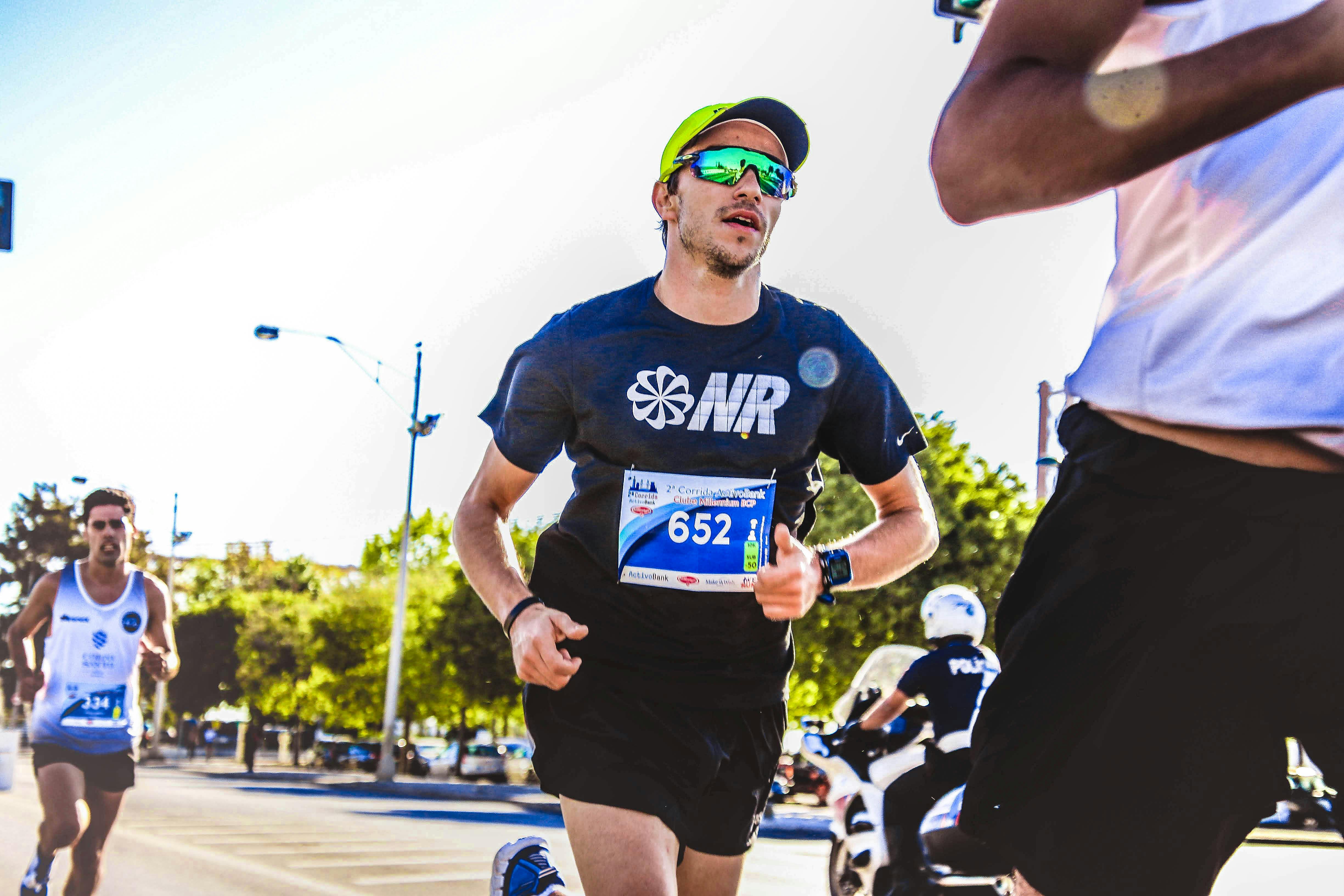In this blog, we’ll give you a comprehensive strength training program specifically designed for distance runners that you can easily do at home.
Key Takeaways
- Boost endurance with strength training: This program focuses on exercises that build muscle endurance and power, helping distance runners improve their speed and stamina.
- Minimal equipment, maximum results: Using tools like the NordStick, OmniBands, and OmniStrap, you can target key muscles for running without the need for heavy gym equipment.
- Prevent injuries and improve performance: Strengthening your legs, core, and lower back reduces injury risk while enhancing your running form and efficiency.
The Benefits of Weight Training for Distance Runners
Weight training can have a profound impact on various aspects of your running performance. Heavy weight training plays a crucial role in enhancing muscle power and running performance. Muscle power significantly contributes to improved running economy and endurance, making it essential for distance runners.
One significant benefit is its effect on muscle mass and body weight. While endurance running primarily relies on aerobic capacity and efficient biomechanics—in short, when you lift weights, you can enhance your overall performance. It also stimulates muscle hypertrophy, increasing muscle size and strength. While some runners may worry that added muscle mass could weigh them down, the reality is that the benefits of increased strength outweigh any potential weight gain.
Incorporating strength training into your running regimen can improve your running economy, which determines how much oxygen is consumed at a given pace. By strengthening key muscle groups involved in running, such as the quadriceps, hamstrings, glutes, and core, you can enhance neuromuscular coordination and efficiency of movement. This means you’ll require less energy to maintain your pace, allowing you to run faster and farther with less effort. Additionally, strength training can enhance muscular endurance, enabling you to maintain proper form and performance over longer distances and training sessions.
How Resistance Training Affects Running Performance
This type of training plays a crucial role in injury prevention for long distance runners. Running places significant stress on the muscles, tendons, and joints, increasing the risk of overuse injuries and imbalances. With strength exercises, you can correct muscle imbalances, strengthen supporting structures, and reduce the likelihood of overuse injuries.
Power training, which includes high-intensity strength and plyometric exercises, is essential for improving running economy and overall muscle power production.
For example, exercises like the Nordic curls and hip abductions target the posterior chain muscles, which are often neglected in traditional running training. Strengthening these muscles can improve running mechanics, reduce the risk of common injuries such as IT band syndrome and patellofemoral pain syndrome, and promote overall longevity in your running career.
Integrating resistance and endurance training into your distance running program can significantly benefit your performance and overall well-being. By developing strength, power, and muscular endurance, you can improve running economy, enhance injury resilience, and ultimately achieve your goals as a distance runner. Whether you’re aiming to set a new personal best or simply enjoy the sport injury-free, incorporating strength training into your routine is a worthwhile investment in your running journey.
Warm-Up
Before diving into your strength training routine, it's important to properly warm up your muscles to prevent injury and prepare your body for the upcoming workout. Here are three dynamic warm-up exercises to get your upper body and lower body muscles primed and ready:
1. Elephant Walks
Stand up and start bending at the waist, reaching down as far as you can. Pump your knees forward and back to feel a stretch in your hamstrings. Continue alternating legs for 20 seconds.
2. Air Squats
Stand with your feet shoulder-width apart. Keeping your chest up and your core engaged, lower your hips back and down into a squat position as if you were sitting back into a chair. Keep your knees in line with your toes and your weight in your heels. Once your thighs are parallel to the ground, push through your heels to return to the starting position. Do it for 20 seconds.
3. Glute Bridge
Lie on your back with your knees bent and feet flat on the floor, hip-width apart. Engage your core and squeeze your glutes as you lift your hips towards the ceiling, creating a straight line from your shoulders to your knees. Hold for a moment at the top, then slowly lower back down to the starting position. Do it for 20 seconds.
The Workout
Now that you’re warmed up, let’s dive into the strength training exercises that will target the muscles used most during distance running. While strength training can enhance overall fitness, it is important to consider the training volume of your running routine to ensure it complements your endurance goals.
1. Nordic Curls (Slow Eccentric Focus to Target)
Starting Position: Kneel on a soft surface with your ankles secured with the Nordstick, or have a partner hold them.
Movement: Slowly (and I mean like more than a 3-second descent) lower your torso towards the ground while keeping your body in a straight line from knees to head. Use your hamstrings to control the descent. Once you’re almost at a point where you can’t help but fall to the ground, push yourself back up to the starting position. Try to perform 3-5 reps for 2 sets.
You can also use support bands like the OmniBands to make sure you don’t crash into the floor as you focus on your descent.
Benefits: Nordic curls target the hamstrings, which are essential for powering your stride and preventing injuries such as hamstring strains. Additionally, they enhance muscle power, significantly improving running economy and overall performance in distance running events.
2. Leg Extension with Omnistrap
Starting Position: Sit on a chair or bench with your back supported and your feet flat on the ground. Secure a dumbbell under one foot using an Omnistrap.
Movement: Extend your leg, lifting the dumbbell towards the ceiling while keeping your knee straight. Slowly lower the weight back down to the starting position. Perform 8-12 reps on each leg for 2 sets.
Benefits: Leg extensions target the quadriceps, helping to improve knee stability and overall leg strength, which is crucial for powering uphill sections during a run. Additionally, this exercise can enhance core stability, making it a valuable component of core training for distance runners.
You can do it with or without the Omnistrap, as long as you find a way to safely add weights on your foot.
3. Hip Abduction
Starting Position: With the dumbbell still strapped on your foot with the Omnistrap, stand up your legs straight.
Movement: Lift your leg sideways, keeping it straight and engaging your outer thigh muscles. Slowly lower the leg back down to the starting position. Aim for 15 reps on each side for 2 sets.
Benefits: Hip abduction strengthens the muscles on the outside of your hips, helping to stabilize your pelvis and prevent IT band issues, which are common among distance runners. This stabilization is crucial for improving distance running performance by enhancing running economy and overall endurance.
4. Hip Flexion
Starting Position: Secure an Omniband or a resistance band on the lower part of your door. Loop the band around your ankle.
Movement: Walk forward and position yourself at a distance where tension is created with the Omniband. Point your foot forward and pull the band, then move your foot back. Alternate legs and perform 15 reps on each side for 2 sets.
Benefits: Hip flexion targets the hip flexor muscles, which are crucial in lifting your knees and driving forward momentum during running. For long distance runners, this exercise enhances endurance, improves running economy, and helps in injury prevention, making it an essential part of their strength training routine.
5. Hip Extension
Starting Position: With the Omniband still secured on the lower part of your door, loop the band around your ankle and face the door at a distance where tension is created.
Movement: Point your foot backward and pull the band, then move your foot back to the starting position. Perform 15 reps on each leg for 2 sets.
Benefits: Hip extension strengthens the glutes and hamstrings, helping to improve your running power and efficiency. This exercise is a key component of power training, enhancing muscle power production and running economy through high-intensity strength and plyometric adaptations.
6. Hip Adduction
-
Starting Position: With the same Omniband position as the Hip Extension, face the side adjacent to the door. Make sure the tension is still there.
-
Movement: Point your foot sideways and slowly bring it back to the starting position. Aim for 15 reps on each side for 2 sets.
Benefits: Hip adduction targets the muscles inside your thighs, helping improve hip stability and prevent injuries such as groin strains. Incorporating hip adduction into your routine can complement the overall training volume for distance runners, enhancing muscle balance and supporting endurance training.
Get the Full Strength Training Program for FREE

Get 8 weeks of workouts incorporated with your runs, complete with rest times, expert advice, and more.
Incorporating a strength training program into your routine is essential for distance runners looking to improve their performance and stay injury-free. Our FREE 10K Success Program, designed by a Boston-qualifying marathoner and expert physical therapist, can help you reach your goals.
Heavy weight training is also included in the full strength training program, focusing on enhancing running performance and muscle power.
By focusing on key muscle groups used during running and utilizing proper form, you’ll develop strength, power, and endurance to surpass your personal best and conquer any distance. Don’t let the opportunity to elevate your running performance pass you by—start lifting weights and reaping the benefits today!
DOWNLOAD THE 10K SUCCESS PROGRAM FOR FREE
FAQs
How should distance runners strength train?
Distance runners should focus on incorporating a balanced strength training regimen into their routine. To enhance running performance and prevent injuries, concentrate on exercises that target major muscle groups, including the core, lower body, and upper body. Core workouts, such as planks and Russian twists, are vital for maintaining stability and improving running economy. Lower body exercises like squats, lunges, and calf raises can boost muscle power and stride length. Upper body strength is also important for maintaining form during long runs, so consider push-ups and rowing exercises.
For effective results, include resistance training sessions two to three times a week, with a mix of moderate loads and body weight exercises. Progress gradually by increasing training volume or intensity to prevent overuse injuries. Additionally, integrating plyometric exercises can aid in reducing ground contact time and improving neuromuscular coordination. Remember, the goal is to enhance endurance without compromising your running training.
What are the best strengthening exercises for distance runners?
For distance runners, focusing on exercises that build overall fitness and muscular endurance is crucial. Start with lower body exercises such as squats and lunges to enhance muscle power and support knee stability, reducing the risk of common running injuries. Calf raises are also essential for strengthening the lower leg, improving running technique, and reducing ground contact time.
Incorporate core training with exercises like planks and Russian twists to increase core strength, vital for maintaining efficient body forms during long runs. Upper body exercises, such as push-ups and pull-ups, are beneficial for improving running economy by ensuring proper form and posture.
To further boost performance, include plyometric exercises like box jumps and jump squats. These exercises enhance force production and stride length, leading to a faster pace. Aim to perform two to three strength workouts per week, focusing on a mix of heavy weight training and body weight exercises to build muscle mass and improve running performance.
How often should distance runners lift weights?
Distance runners should aim to incorporate weight training into their routine about two to three times per week. This frequency allows for improved muscle strength and endurance without compromising the running training schedule. By lifting weights consistently, runners can prevent injuries and enhance their distance running performance.
Each session should focus on key muscle groups, including the lower body, upper body, and core. Emphasize exercises that support muscle power and strength endurance, such as squats, lunges, and planks. Incorporating moderate loads with body weight exercises can also help maintain balance and flexibility.
It's essential to allow time for recovery between strength training sessions, which helps in muscle fiber repair and reduces injury risk. Highly trained runners might adjust the training volume based on their fitness level and specific goals. Remember, the objective is to complement endurance training, improve running economy, and support long distance runs by building muscle strength and overall fitness.
Do elite distance runners lift weights?
Yes, elite distance runners often incorporate weight training into their routines. This practice is crucial for enhancing running performance, maintaining muscle strength, and preventing injuries. Weight training helps improve muscle power and neuromuscular coordination, allowing elite runners to maintain a faster pace over long distances.
Elite runners typically focus on exercises that enhance key muscle groups used in running. These include squats, lunges, and calf raises for the lower body, as well as core workouts like planks to boost core strength. Upper body exercises such as rowing and push-ups help maintain form during intense training sessions.
The training volume and intensity are tailored to their specific needs and goals, often guided by a personal trainer. By incorporating strength exercises, elite runners can optimize their running economy, reduce ground contact time, and improve stride length. Ultimately, weight training is an integral part of their comprehensive running training program, supporting maximal oxygen uptake and overall athletic performance.












































Leave a comment
This site is protected by hCaptcha and the hCaptcha Privacy Policy and Terms of Service apply.